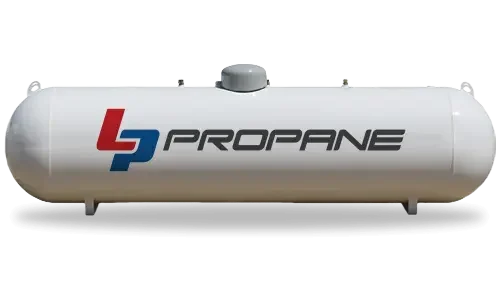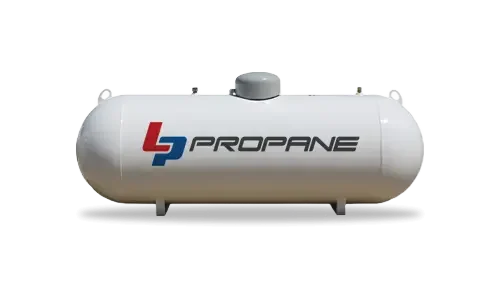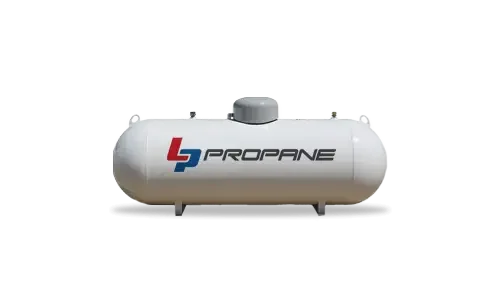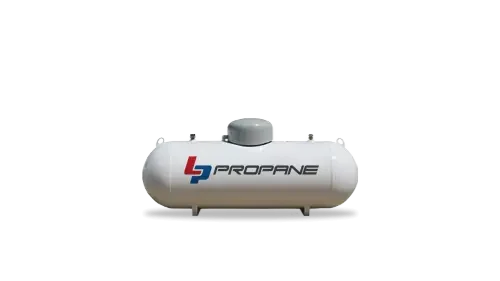Understanding Propane Tank Dimensions:

1,000
Gallon

500
Gallon

250
Gallon

120
Gallon
The Importance of
Propane Tank Dimensions
Efficiency: Selecting a propane tank that fits your needs ensures optimal efficiency. A tank that’s too small will require frequent refills, while one that’s too large can lead to wasted fuel and unnecessary costs.
Safety: Understanding tank dimensions helps ensure safe storage and transportation. Compliance with local regulations and safety standards is essential to prevent hazards.
Convenience: Choosing the right size means less hassle. You’ll enjoy uninterrupted service and peace of mind knowing your propane supply meets your demands.
Types of Propane Tanks
Before diving into dimensions, it’s essential to understand the different types of propane tanks available:
Portable Tanks: Often used for grills, camping, and outdoor heaters, these tanks are generally smaller, ranging from 20 to 40 pounds.
Residential Tanks: These larger tanks are used for home heating, hot water, and cooking. They typically range from 120 gallons to 500 gallons.
Commercial Tanks: For businesses that require a significant propane supply, commercial tanks can range from 500 gallons to 1,000 gallons or more.
Standard Propane Tank Dimensions
Let’s break down the standard dimensions for the most common propane tanks:
20 lb Propane Tank
- Height: Approximately 18 inches
- Diameter: About 12 inches
- Capacity: 4.7 gallons (filled with approximately 20 pounds of propane)
Usage: Ideal for small grills, outdoor heaters, and portable appliances.
30 lb Propane Tank
- Height: Approximately 24 inches
- Diameter: About 12 inches
- Capacity: 7.1 gallons (filled with approximately 30 pounds of propane)
Usage: Commonly used for larger grills and camping equipment.
40 lb Propane Tank
- Height: Approximately 29 inches
- Diameter: About 12 inches
- Capacity: 9.4 gallons (filled with approximately 40 pounds of propane)
Usage: Suitable for commercial cooking equipment and larger outdoor heaters.
100 lb Propane Tank
- Height: Approximately 48 inches
- Diameter: About 14 inches
- Capacity: 23.6 gallons (filled with approximately 100 pounds of propane)
Usage: Often used for residential heating and larger appliances.
250 Gallon Propane Tank
- Height: Approximately 4 feet
- Diameter: About 30 inches
- Capacity: 250 gallons (filled with approximately 2000 pounds of propane)
Usage: Common for residential heating, water heating, and cooking.
500 Gallon Propane Tank
- Height: Approximately 5 feet
- Diameter: About 41 inches
- Capacity: 500 gallons (filled with approximately 4000 pounds of propane)
Usage: Used for larger homes or businesses with substantial heating needs.
1000 Gallon Propane Tank
- Height: Approximately 6 feet
- Diameter: About 41 inches
- Capacity: 1000 gallons (filled with approximately 8000 pounds of propane)
Usage: Typically used for large commercial applications, industrial purposes, or multiple homes.
Factors to Consider When
Choosing Propane Tank Dimensions
When selecting a propane tank, several factors come into play:
Usage Needs: Determine how much propane you’ll need based on your specific applications—residential heating, cooking, or industrial use.
Space Constraints: Assess the available space for tank installation. Larger tanks require more room and need proper ventilation.
Local Regulations: Check local codes and regulations governing propane tank installation and usage. Compliance is critical for safety.
Refill Frequency: A larger tank may reduce the frequency of refills, but ensure it aligns with your consumption rate to avoid waste.
Safety Considerations for Propane Tanks
Understanding tank dimensions also contributes to safety. Here are some critical safety tips:
Proper Installation: Always hire a certified technician for tank installation. This ensures compliance with safety standards and regulations.
Regular Inspections: Schedule routine inspections to check for leaks, corrosion, and overall tank condition.
Ventilation: Ensure the tank is installed in a well-ventilated area to prevent the accumulation of gas.
Emergency Preparedness: Have an emergency plan in place, including leak detection methods and access to safety equipment.